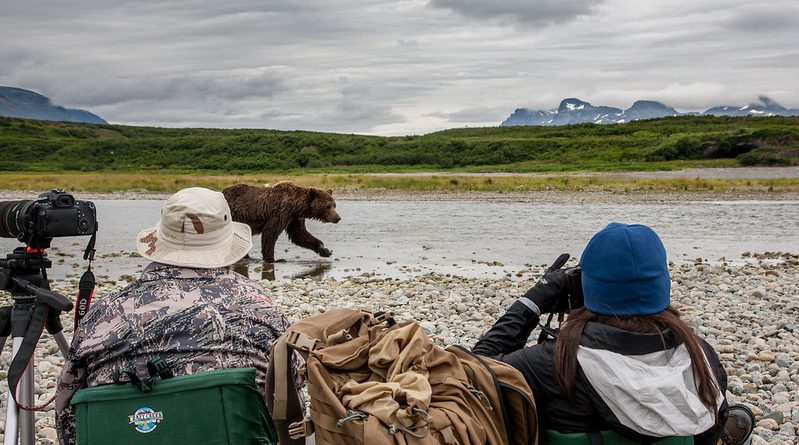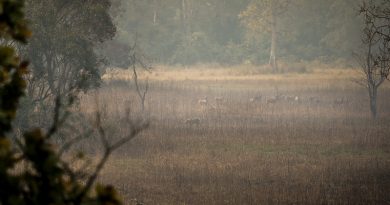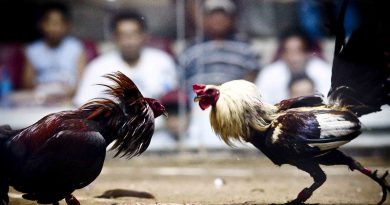Up Close to Brown Bears at the McNeil River
Nature Facts
Name: Brown Bear, also known as a ‘grizzly bear’
Appearance: Mammal, four legs, cuddly yet ferocious!
Where: Alaska & Rocky Mountain states USA, Canda, parts of Asia & Europe.
Best sighting: Mc Neil River Falls, Alaska
Be Prepared: Bring waterproofs, tents, cooking & hiking gear
At the McNeil River Falls in July and August, up to 100 brown bears can be seen gorging themselves on the Salmon run. It is a unique event rarely seen in nature as bears seldom congregate in numbers anywhere else in the world. Mc Neil River is a road less area undisturbed by development about 250 miles south west of Anchorage and 100 miles west of Homer.

Visitors to the McNeil River must be entirely self sufficient and be prepared for the real and dangerous life in the wilderness. A good tent, water proof clothing and hip boots are necessities in wading through the knee deep waters around the falls. You will need a permit from the McNeil River State Game Sanctuary to photograph in the area to limit human invasion. If you want to visit, demand is so high amongst photographers than permits are issued using a lottery drawn on the 1st March each year.
If you’re into bear watching, you should treat the beasts with respect, and stay at least 100 yards away. To minimise bear conflicts, keep food odours to a minimum, sore food away from camp and don’t camp on known bear routes.
The Bear Facts
Brown bears live throughout Alaska, and they also frequent Asia, Canada, Europe and a few USA states. There is even a pit of bears in Switzerland’s capital city, Bern, whose name translates as “bear”. However, the brown bear very much epitomises the face of Alaskan wildlife and 98% of bears in the Americas live here. The concentration of bears in Alaska range from one bear for every 300 sq miles to one bear per mile nearer food sources and rivers.
“Brown bear” is commonly used to mean either brown or grizzly bears. The brown bear resembles the black bear, but is larger with longer claws used for digging in small animal burrows. They are capable of running the chase with moose or caribou. During the winter in their extreme fatty states, a mature male bear can weigh from 500 to 1,400 pounds and standing on their hind legs can stand up to 9 ft tall. This is not usually to charge but to test the wind and gain a better vision. Most bears live to the age of around 20 and are born with a great sense of smell and can sniff a meal up to a mile off.
Bears mate from May to July, June is the big month for lovemaking. They rarely have strong ties to their mates and males often mate with more than one female in a season. Litters are born in the winter and range from one to four cubs, usually two. They will stay with their mother for 2 to 3 years and she will fiercely protect her young against larger predators and even their own father who may attack the young. when the mother will breed again.
The mighty beast will eat a wide range of foods, from grasses, berries, fish , squirrels, roots and plants to moose and caribou. They also like wallowing in human rubbish dumps if they have the chance.
Bears hibernate throughout the winter, the length depending on the coldness of the region; some do not hibernate at all, others further north may hibernate for up to 7 months a year. The mother will oftenstill be in hibernation when her cubs are born. The baby bear, who is bald and blind at birth, will snuggle into a nursing position to suckle on her fatty milk. By the time she awakes from her long sleep, baby bear will be able to walk out of the den on four legs. If only child rearing were as hassle free for humans! Half of bear cubs die within a year of birth. Disease, predators and starvation are all threat to a cub if it becomes stranded from its mother.
Bears are usually solitary, and do not hang around in groups, unless there is a place like theMcNeil river when food is concentrated, then many bears may centre around the salmon. This is why the McNeil river is unique in the world as the site for seeing so many bears simultaneously, where their favourite dish is dog salmon which they guzzle by the tummy load. The bears have different fishing techniques, ranging from observing the stream and pining down the fish to snorkelling and diving for fish.
What to do if you come face to face with a bear
If you’re in Alaska and come face to face with a bear, there are do’s and don’t’s. Don’t run because bears can run faster than humans and if you flee it is a natural signal for the bear to attack. Back up slowly and talk to it. If it charges, there’s a good chance that it will be bluffing. It it’s going to attack, drop to the ground in the foetal position, put your hands behind your head and hope for the best. The chances are, despite their size, the bear is more frightened of you attacking its child or food supply than it is sourcing you out for its next meal.
It’s assumed that men and bears do not mix, but at the McNeil sanctuary has proved this wrong. There have been no cases of bears attacking humans since the sanctuary was opened in 1972. Feeding of bears is forbidden throughout Alaska, and no bears are allowed in camps. The bears at McNeil falls are usually highly tense as competition for salmon is fierce and it is rare for the bears to be in the company of one another. But strangely for their aggressive personality, bears rarely fight one another, the smaller bear will usually back away but never turn and flee, or this triggers an aggressive masculine instinct in the superior bear and he will instinctively attack.
MORE INFORMATION
BearCam
National Geographic’s on the fly webcam of Alaskan brown bears.
Brown Bear
All you’ve ever wanted to know about brown bears.
The Bears at McNeil River
Excerpts from the book The Alaska Wilderness Guide by Bill Sherwonit on how to best view the McNeil bears.
For Bear watching permits at the Mc Neil River contact:
Alaska Department of Fish and Game
Division of Wildlife Conservations
333 Raspberry Road
Anchorage, Alska 99518-1599
ATTN: McNeil River
Telephone: 001 (907) 267-2182




